Vol 3 No. 06 TROPIC LIGHTNING NEWS February 5, 1968
Index
Yellowstone Continues In War Zone C
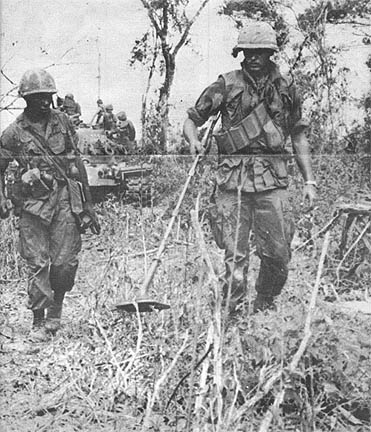 |
| LOOKING FOR TROUBLE - A mine detector team from the 1st Bn (Mech), 5th Inf, sweep ahead of a 2nd Bn, 34th Armor tank during a search and destroy mission in War Zone C. The unit is participating in the 25th Div's Operation Yellowstone. (Photo by SGT Roger Smith) |
Infantrymen Kill 44 Cong In HoBo Woods
2ND BDE - Operation Saratoga infantrymen killed 44 enemy troops in two
day-long battles throughout the HoBo Woods recently, while six more enemy died
in scattered action throughout Hau Nghia Province.
The 2nd Bde soldiers further uncovered an underground storage room containing
271 RPG-2 rockets and 162 booster charges.
The two battles left three Americans killed and 21 wounded.
Elements of the 4th Bn (Mechanized), 23rd Inf, moving ahead of land clearing
teams in the southern portion of the HoBo Woods, came in heavy contact with an
estimated two companies of Viet Cong.
In the ensuing fight, punctuated by periodic lulls as the enemy tried to
break contact, 8 communists were killed and two RPD-56 light machine guns, an
AK-47 and an AK-50 assault rifle captured.
Armed helicopters poured fire on the enemy positions. Artillery from the
brigade base at Cu Chi and from a forward support base of the 1st Bn, 8th Arty,
pounded the communists. Air Force tactical fighters conducted two air strikes.
During a search and destroy mission three days later, infantrymen found a
grave containing 36 more bodies.
In the second action, two companies of the 2nd Bn, 27th Inf "Wolfhounds,"
supported by helicopter gunships, systematically gunned down 20 communists in a
day-long series of skirmishes in scrub brush, rice paddies and swamps at the
western edge of the HoBo Woods.
Suffering only two wounded, the Wolfhounds rooted the enemy troops from
spider holes, bunkers and tunnels as they conducted a search and destroy mission
through the area.
Gunships from the 116th Aslt Hel Co killed five enemy soldiers as they
attempted to escape.
Brigade intelligence officers identified the Viet Cong force as a company of
the 1st Bn, MR IV Main Force Regiment.
The Wolfhounds captured two AK-47 and two SKS assault rifles, one CKC
automatic weapon and a U.S. carbine, as well as numerous documents, web gear and
ammunition.
In other actions, a 2nd Bde forward air controller flying over the Oriental
River on a visual reconnaissance mission, came under fire from two Viet Cong in
a sampan. He called for artillery fire which killed both enemy and sank the
supply-laden sampan.
Members of the Combined Reconnaissance and Intelligence Platoon (CRIP),
killed one communist, detained four suspects and captured two U.S. grenades in a
brief skirmish in southern Hau Nghia Province.
Elements of Delta Co, 2nd Bn, 27th Inf, uncovered three communist bodies in
fresh graves the day before their fight with the VC company.
The night before its battle, the 4th Bn, 23rd Inf, came under a heavy mortar
barrage, but suffered no casualties. Communist gunners poured 115 rounds of
82mm mortar fire on the base camp, accompanied by light ground fire.
The U.S. troops returned fire with mortars, artillery, .50 cal. machine guns
and other weapons, with unknown results.
The large cache of RPG rounds and booster charges was found by elements of
the 27th Land Clearing Team and the 23rd Inf's reconnaissance platoon as they
swept through an area in the HoBo Woods.
Hidden in a storage room within a small bunker, the rounds bore Chinese
markings. They were later evacuated.
Page 2 TROPIC LIGHTNING NEWS February 5, 1968
Decorated
| Distinguished Flying Cross | |
|
MAJ Dale E. Snell, 116th Aslt Hel Co, 269th Avn Bn 1LT Frank S. Owen Jr., Co 8, 25th Avn Bn 1LT Justin C. Honaman, 577th Med Det (HA) 1LT Francis L. Briganti, 116th Aslt Hel Co, 269th Avn Bn 1LT Michael H. Adkinson, 116th Aslt Hel Co, 269th Avn Bn |
1LT Howard O. Sturgis Jr., 116th Aslt Hel Co, 269th Avn Bn CW2 Jimmy Swindle, 116th Aslt Hel Co, 269th Avn Bn WO1 Michael G. Grinot, Co B, 25th Avn Bn WO1 Richard A. Price, 116th Aslt Hel Co, 269th Avn Bn WO1 John H. Harrington, 116th Aslt Hel Co, 269th Avn Bn |
Bronze Star Medal (Valor) |
|
|
CPT William H. Coad, HHB, 3rd Bn, 13th Arty CPT Lawerence Dimichele, Co A, 2nd Bn, 34th Armor CPT Randall T. Elliot, HHC, 2nd Bn, 12th Inf CPT Sidney P. Stone, HO Btry, 3rd Bn, 13th Arty 1LT David L. Wiesman, HHB, 2nd Bn, 77th Arty 1LT Bruce D. Jackson, HHC, 2nd Sn, 77th Arty 1LT Douglas B. Lawson, Co A, 2nd Bn, 12th Infantry SGM Yukio Suenishi, HHC, 2nd Bn, 12th Inf SSG Alfred L. Knopsnyder, Co C, 2nd Bn, 14th Inf SSG Anthony Leibhart, HHC, 2nd Bn, 12th Inf SGT David H. Moran, Co C, 3rd Bn, 22nd Inf SGT Clyde K. Taylor, HHB, 2nd Bn, 77th Arty SGT Gary R. Koenig, Co A, 2nd Bn (Mech), 22nd Inf SP5 Horace A. Boyd, Co B, 25th Avn Bn |
SP4 Michael J. Rupolo, Co A, 2nd Bn (Mech), 22nd Inf SP4 Willie W. Bacote, Co A, 2nd Bn, 12th Inf SP4 Nickolas P. Bartell, 2nd Bn, 34th Armor SP4 Donald W. Whipp, Co C, 4th Bn, 9th Inf SP4 Lawrence Osborne, Co B, 2nd Bn, 12th Inf SP4 Malcolm A. Seay, Co B, 2nd Bn, 12th Inf PFC Gildardo Soto, Co B, 2nd Bn, 12th Inf PFC John L. Miller, HHB, 2nd Bn, 77th Arty PFC Murray Birnbaum, Co C, 4th Bn, 9th Inf PFC Henry P. Ford, Co C, 4th Bn, 9th Inf PFC Peter J. Schembri, Co A, 4th Bn, 9th Inf PFC George W. Nealy, Co A, 2nd Bn, 12th Inf PFC Given W. Bradley, Co A, 2nd Bn, 12th Inf PFC Robert L. Done, HHB, 3rd Bn, 13th Arty |
Army Commendation Medal (Heroism) |
|
|
1SG Raymond Caudle, 116th AsIt Hel Co, 269th Avn Bn SSG James L. Fettkether, Co B, 2nd Bn, 12th Inf SGT Lloyd G. Divel, Co B, 2nd Bn, 12th Inf SP5 Mariano Miguel Jr., 116th Ash Hel, 269th Avn Bn SP5 Santos Garcia Jr., 116th Aslt Hel Co, 269th Avn Bn SP5 Antonio G. Roseia, 116th AsIt Hel Co, 269th Avn Bn SP4 Thomas H. Bergren, 116th AsIt Hel Co, 269th Avn Bn SP4 David G. Ruiz, 116th AsIt Hel Co, 269th Avn Bn SP4 William B. lanigan, 116th Ash Hel Co, 269th Avn Bn PFC Jack J. Szentmiklosi, 116th AsIt Hel Co, 269th Avn Br PFC Ronald R. Baker, 116th AsIt Hel Co, 269th Avn Bn |
PFC Jerry W. Okinga, 116th Ash Hel Co, 269th Avn Bn PFC Charles Wickliffe, Co B, 2nd Bn, 12th Inf PFC Robert T. Colley, Co B, 2nd Bn, 27th lnf PFC Billy F. Stewart, Co A, 2nd Bn, 12th lnf PFC Gary L. Lawerence, Co A, 2nd Bn, 12th Inf PFC Anthony G. Ignash, Co A, 2nd Bn, 12th lnf PFC Houston T. Williamson, Co A, 2nd Bn, 12th lnf PFC Louis Collier, HHC, 2nd Bn, 12th lnf PFC David L. Mathias, 116th Aslt Hel Co, 269th Avn Bn PFC Richard M. Robinson, 116th Ash Hel Co, 269th Avn Bn PFC Roger Jensen, 116th Ash Hel Co, 269th Avn Bn |
EDITORIAL
Saving to Help 'Uncle'
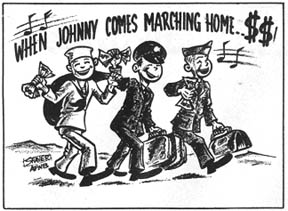 President Johnson has appealed to all U.S. citizens for help in solving a
problem "of vital concern to the economic health and well-being of this Nation
and the Free World."
President Johnson has appealed to all U.S. citizens for help in solving a
problem "of vital concern to the economic health and well-being of this Nation
and the Free World."
The problem is not a new one. It concerns the "international balance of
payments" and affects every U.S. serviceman and his family now serving or about
to serve abroad.
But how does this "international balance of payments" situation touch a
serviceman and his family? What can he do to help?
The answer is simple: "Buy" and "Save" American.
Every dollar a serviceman spends for goods produced by Uncle Sam helps; every
American dollar he invests in U.S. Savings Bonds, Freedom Shares or the
Uniformed Service Savings Deposit Program also helps.
And in the "savings" programs you get paid for the privilege. U. S. Savings
Bonds will pay you 4.15 percent interest; Freedom Shares pay 4.74 percent
interest in only 4%i years; and at overseas stations the Uniformed Services
Savings Deposit Program pays 10 percent interest.
New GI Bill For Pilot Training
Five new categories of specialized flight training are now open to veterans
training for civilian flying jobs under the GI Bill.
The Federal Aviation Administration, after a number of requests from veterans
for more advanced training, has approved these types of training:
• "Class" ratings to cover additional aircraft categories.
• Additional ratings to be added to instructor certificates.
• Proficiency training to prepare for an airline transport rating.
• Proficiency training for certification as a rotorcraft external load
operator or chief pilot.
• Proficiency training for certification as an agricultural aircraft
operator or supervisor.
Previously, the only FAA-approved courses were those leading to a certificate
as a commercial pilot, flight instructor or instrument-rated pilot. The FAA
action makes veterans enrolling in the advanced flight training courses eligible
for reimbursement by the Veterans Administration.
New Currency Control Measures To Set $200 Transaction Limit
SAIGON (MACV) - A significant change in currency control measures starting
March 1 and phased over a five to six month period was announced recently by a MACV headquarters spokesman.
Key to the planned changes, aimed at personal currency transactions, is the
first phase introduction of a currency control form and establishment of a limit
of $200 per month on cash transactions involving Military Payment Certificates (MPC).
The second phase of the change will be the issuing of an embossed MACV
Currency Control Card to each individual subject to the system and establishing
computer records for those individuals. The embossed card will not be used as
evidence of entitlement to any privilege.
The Currency Control Form (MACV Form 385) will be used when MPC are converted
to U.S. currency (green), when converting MPC to dollar instruments (postal
money orders, treasury checks, traveler's checks, etc.) or when depositing MPC
to bank accounts or United Services Deposits Program.
Only cash deposits come under the $200 limit in the latter case. Deposits to
banks or the Savings Deposits Program by check or allotment are not subject to
this restraint.
Exceptions to the $200 limit will be authorized only when an individual is
leaving the Republic of Vietnam on R&R, permanent change of station, leave,
etc., or when a bonafide personal emergency arises that requires purchase of
dollar instruments in excess of $200.
Anytime an exception to the $200 limit is authorized, the individual must
obtain a certificate from his commander or supervisor that the MPC in excess of
$200 was legitimately acquired.
The MACV Form 385 will also be required when making purchases from the
Vietnam Regional Exchange of cameras, television sets, tape recorders,
tuner/amplifiers, refrigerators, fans, radios, airline tickets and automobiles.
The $200 monthly limitation on convertability of MPC is not a limit on how
much pay an individual may draw in-country.
If an individual's pay is sent to a bank by the servicing finance/disbursing
office, or if he is paid by check and he deposits the check to a bank account,
subsequent check transactions by him are not subject to the $200 limit.
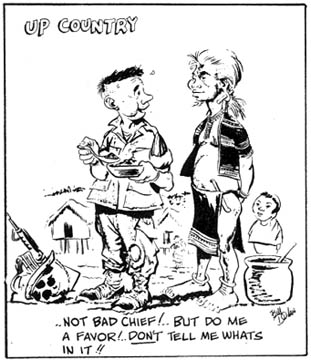 |
The TROPIC LIGHTNING NEWS is an authorized publication of the 25th Infantry Division. It is published weekly for all division units in the Republic of Vietnam by the Information Office, 25th Infantry Division, APO San Francisco 96225. Army News Features, Army Photo Features, Armed Forces Press Service and Armed Forces News Bureau material are used. Views and opinions expressed are not necessarily those of the Department of the Army. Printed in Tokyo, Japan, by Pacific Stars and Stripes.
MG F. K. Mearns . . . . . . . . . . . . . . . Commanding General
MAJ. Bernard S. Rhees . . . . . . . . . . Information Officer
SSG Dave Wilkinson . . . . . . . . . . . . Editor
SP4 Dave Cushman . . . . . . . . . . . . . Editorial Assistant
Page 3 TROPIC LIGHTNING NEWS February 5, 1968
We Are Winning Viet War, JCS Chairman Tells
Audience
"The single most important factor in prolonging the war [in Vietnam] is
Hanoi's calculation that there is a reasonable possibility of a change in U.S.
policy before the ultimate collapse of the Viet Cong manpower base and
infrastructure."
That statement was made by GEN Earle G. Wheeler, chairman of the Joint Chiefs
of Staff, before the Economic Club of Detroit.
"I am convinced of four things: (1) We are winning the war in Vietnam; (2) I
cannot predict when the war will end; (3) although the tide of battle is running
against Hanoi, they are not yet convinced that they cannot win, and (4) flowing
from item 3, Hanoi is not yet ready to negotiate an end to the war."
GEN Wheeler said that if we stop bombing
• The North Vietnamese would be able to put men and supplies into the south
at lower cost.
• The material resources available to them would be increased, which would
enable them to support more men in combat in the south or make life in the north
easier, or both.
• It would be a lot easier for them to prolong the war in hopes of a change
in U.S. policy.
"Therefore," he explained, "we cannot stop the bombing of North Vietnam until
we have some indication - some decent hope - that the other side intends to move
toward peace, rather than merely to conduct a war on more advantageous terms."
The general said the United States has been concerned about Vietnam for many
years. He said that late in 1964 the fabric of South Vietnamese society was
coming apart at the seams - that throughout South Vietnam communist forces had
seized the initiative. By February 1965 the situation was desperate. This is
when the United States began bombing North Vietnam and "probably saved South
Vietnam from collapse."
"Nevertheless, the communists could see that victory was still within their
grasp. They rapidly stepped up the infiltration of troops from the north in an
attempt at a quick victory before American military power could stop them. From
prisoners and captured documents we have learned that they hoped to cut South
Vietnam in two by the end of the summer of 1965. The prompt arrival of U.S.
troops thwarted that objective - as witness the decisive military actions in the
battles of Plei Me and Ia Drang Valley."
After losing ground and battles during 1966 and 1967, said the general, "the
North Vietnamese once again had to lower their sights. Now their objective
became not a military victory, but war prolongation - part of an effort to wear
down American will to continue. They had learned that their main force units
were unable to stand up to the mobility and firepower of U.S. and allied
forces. They saw in late 1966 and early 1967 that we were beginning to destroy
their key base areas which had been inviolate sanctuaries for 20 years.
"To stem the erosion of the Viet Cong's power base, the communists have
sought to divert allied forces from the heartlands of South Vietnam to the
border areas. In the process, they sought to increase the attrition on U.S.
forces and, if possible, seriously undermine support of the war on the home
front by annihilating a battalion or two of our forces in a miniature
re-enactment of Dien Bein Phu.
"This new communist strategy was responsible for the heavy fighting in the
DMZ area this summer - and more recently the actions along the western
boundaries of South Vietnam - such as Loc Ninh and Dak To."
GEN Wheeler also cited these significant facts:
"First, communist strategy has not thwarted steady progress in revolutionary
development. In fact, that program is gathering momentum.
"Second, they have not achieved even a miniature Dien Bien Phu - as a matter
of fact, they have not scored a significant military success in at least
eighteen months.
"Third, this has been for them an extremely costly strategy. While they may
consider it the best option open to them, it is not an ultimate 'win' strategy."
| TIGHT SQUEEZE - PFC Phillip Boardman drops into the entrance of a VC tunnel uncovered during a search and destroy mission by the 1st Bn, 27th Inf "Wolfhounds," during Operation Saratoga. (Photo by SP4 George Pullen) |
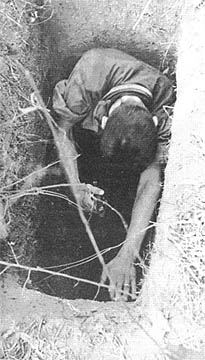 |
12th Evac Hosp Is "Personalized"
SAIGON (ARC-IO) - An American soldier has just been shot by a sniper while
patrolling the Vietnamese jungle near the Cambodian border. He receives first
aid from a medical corpsman on the scene who stops the bleeding and applies
temporary bandages, while a rescue helicopter descends to pick him up. Minutes
later, the wounded man is being treated by U.S. Army doctors in the 12th Evac
Hosp at Cu Chi.
The mission of the 12th Evac Hosp is to give immediate medical care and
stabilize the condition of wounded servicemen until they may be safely moved.
Those with minor wounds - approximately half of the patients - are able to
rejoin their units after a short stay. Of the remainder, half are moved to
convalescent centers located elsewhere in Vietnam, while the more seriously
wounded are evacuated to military hospitals in the U.S.
But emergency medical care is not all that the 12th Evac provides: a staff of
trained Red Cross women assists the military by providing patients with the kind
of personal attention that doctors - struggling to save lives and repair the
human damage of war - are too busy to give. These women do their best to make
hospitalization more comfortable for sick and wounded GIs by furnishing needed
personal articles, medically-approved recreation facilities and supplies, and by
helping to ease the patient's minds about the things that trouble them, such as
problems of communication with home.
The Red Cross workers at the hospital are not alone in their efforts to make
life easier for wounded soldiers. The American Red Cross chapter in Kansas City
has "adopted" the 12th Evac Hosp at Cu Chi. Through a program called OPERATION
HELPMATE, Red Cross volunteers at home are busy gathering paperback books and
magazines, toilet articles, ballpoint pens and stationery, games and playing
cards, recording tapes for messages to worried families at home, and a variety
of other personal items to make hospitalization easier for patients at the
'12th.'
These articles are shipped to the Red Cross women at the hospital and
distributed to the patients when they make their regular rounds in the wards.
Since last April, the Greater Kansas City Red Cross chapter has sent 3-4 cartons
each month to the 12th Evac. Said Miss Cathy Carlin, of Cleveland, Ohio: "The
Chapter has been extremely thoughtful and generous with its assistance. We've
received two portable tape recorders for use in the wards; a polaroid camera, so
that the men can send pictures of themselves home to reassure their families;
inexpensive birthday gifts for the men; U.S. travel posters to decorate the
lounge; Christmas cards, ribbon and gift-wrapping paper; and many other items,
large and small, that we've made special requests for."
Cathy is one of three American Red Cross workers at the '12th,' including
Pearl Hayes of Wayneville, N.C., and Gwen Turbeyfield, from Tacoma, Wash: There
are more than fifty young women now serving 1-year tours of duty with the Red
Cross at U.S. military hospitals throughout Vietnam. All are college graduates
trained in social work and recreation, and all worked in military hospitals in
the U.S. before assignment in Vietnam.
Their duties are many: They visit each man shortly after his admittance,
bring him a comfort kit so he may wash his face and shave (patients arrive at
the hospital directly from the field with no personal belongings), and see if he
has any special needs or wishes to contact his unit for any reason. The Red
Cross workers operate the recreation lounge within the hospital complex where
convalescing patients may gather to read, listen to music, play ping-pong or
pool, have a game of cards, or simply enjoy a chat with an American girl. They
make daily rounds to talk to patients in the wards, go shopping or buy money
orders for them, arrange phone calls (the military provides each patient with
one telephone call home free of charge), and distribute recreation materials and
needed personal articles. They handle individual problems and give casework
services normally provided by Red Cross Field Directors serving with able-bodied
troops. And perhaps most important of all, they give the men the individual
attention and comfort which is psychologically necessary for speedy recovery.
As long as the Vietnam war continues, the Red Cross workers at the 12th Evac
Hosp in Cu Chi will continue to comfort its casualties, daily bringing smiles
and encouraging words to every wounded man.
Has Trap-Dream, Steps On Same
1ST BDE - SGT John Onhaus, from Pittsburgh, doesn't claim to be clairvoyant
but he does believe in intuition.
The 4th Bn, 9th Inf, sergeant was point man during a recent search and
destroy mission in War Zone C, when he began having odd thoughts.
"All of a sudden and for no reason at all, I began thinking about boobytraps,"
relates Onhaus. "Not just boobytraps in general, but rigged 155mm artillery
shells.
"I hadn't gone too far when I felt something tight against my left leg. I
looked down and saw that it was a wire running across the path to a clump of
brush about five meters to my left."
Onhaus froze in position and called to the men behind him, who moved up and
checked the clump of brush. Hidden under its camouflage was a boobytrapped
155mm artillery shell.
Page 4-5 TROPIC LIGHTNING NEWS February 5, 1968
Story and Photos by SP4 Robert Rossow
3RD BDE - In a unique display of aerial mobility, the 2nd Bn (Mech), 22nd Inf,
accomplished a vital piece of resupply work, airlifting two M-113 Armored
Personnel Carriers (APC) by CH54 "Flying Crane" from their Dau Tieng base camp
to a forward base near the Cambodian border. The vehicles were dispatched to
fill shortages caused by weeks of hard campaigning in the border regions.
CPT Theodore R. Sucher III, the battalion S-4, commented that airlifting APCs
is rarely done, but that it is, nevertheless, not exceedingly difficult.
"Weight is the main problem," said Sucher. "Slings and attachments strong
enough to support the weight of an APC have to be procured. The track has to be
stripped. After making reservations for the 'Crane,' final coordination between
the pad crews and mechanics both in base camp and the field is made. The bird
comes and goes, and it's all over. With our competent mechanics, the tracks
will be combat ready a few hours after they are deposited in the field."
The two vehicles were unable to travel with the battalion when it moved out
on Operation Yellowstone due to mechanical difficulties sustained in the
previous operation. One required a new power pack, and the other repair of an
idler arm which had broken away from the hub. When the repairs were completed,
the only way to get the APCs to the field was by air.
To prepare the APCs for airlift, four mechanics, directed by MSG John
Pobodinski were assigned to disassemble the vehicles. Due to weight limits, it
was necessary to totally strip them. First the mechanics removed the power
packs, completely testing their performance before shipment on a test stand
devised by the "Triple Deuces" maintenance section, then packaged them for
airlifting. Then the basic load of ammunition was removed along with the basic
issue items and personal belongings of the crew members. They then towed the
two vehicles to the helicopter landing pad, where the tracks were removed to
prevent damage to the suspension system during transit, and the carrying slings
attached in preparation for flight.
On the appointed hour, the 'Crane' settled down over the first APC like a
giant predatory insect descending upon its quarry. A man from the pad crew
battled the fierce downwash from the rotors as he struggled to fasten the
carrying hook. When the slings were attached, the 'Crane' lifted slowly off the
pad taking up the slack; then with a staggering lunge, track and helicopter were
airborne. Some twenty minutes later the 'Crane' set the track down at the
battalion's advanced support base miles away near the Cambodian border, and
returned to repeat the performance.
The Triple Deuces field maintenance section has had a great deal of
experience at major field maintenance, and has several times replaced power
packs away from base camp; so, aside from the airlift factor, the reassembly of
the vehicles was a routine job.
| "TRIPLE DEUCES" MECHANICS REMOVE TRACKS FROM APC IN PREPARATION OF AIRLIFT. |
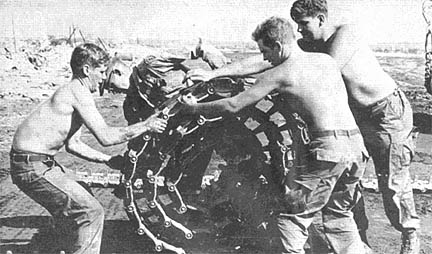 |
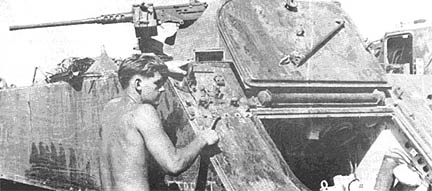 |
SP4 WAYNE KRYSTER OF THE 2ND BN, 22ND INF, READIES THE APC FOR AIRLIFT. |
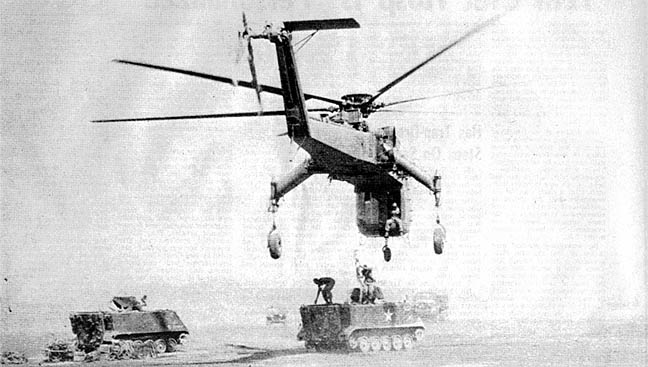 |
| THE GIANT CRANE HOVERS OVER THE APC AS MEN OF THE "TRIPLE DEUCES" FINISH LAST MINUTE PREPARATIONS OF THE VEHICLE FOR AIRLIFT. |
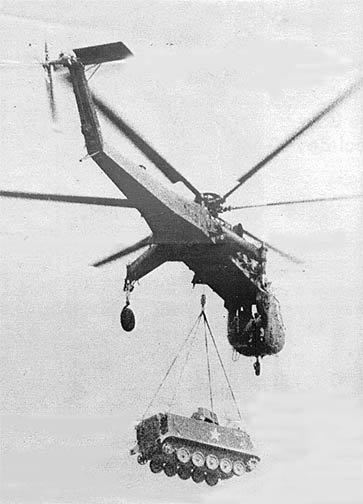 |
SLOWLY THE GIANT CRANE MOVES OFF WITH THE APC TOWARD THE FORWARD BASE CAMP OF THE "TRIPLE DEUCES." |
Page 6 TROPIC LIGHTNING NEWS February 5, 1968
One-man Skirmish Stops VC Laughs
1ST BDE - In the darkness, SGT E. W. Tolbert of Cleveland, Miss., heard
movement to his front, laughter to his right, and saw the claymore mine wire on
his left jerk sharply.
"I swear I thought I was in an amusement park fun house," says Tolbert
describing his experience as a perimeter guard in a War Zone C forward fire
support base manned by the 4th Bn, 9th Inf.
Seconds later, Tolbert found what he was facing. "That's when I saw them,"
he related. "Three VC on my left and five more setting up a machine gun to my
right. The VC on the machine gun started laughing again and that's how they
died . . . laughing."
Without hesitation, Tolbert had whirled around and opened fire with his M-16,
killing the VC to his left, and then swung around and killed the machine gun
crew.
Asked later if he was scared, Tolbert replied, "I reacted so fast, that I
didn't become scared till it was over."
What the sergeant didn't know at the time of his one-man skirmish, was that a
short time later, a large Viet Cong force would attempt to overrun the base
camp.
At daybreak, searchers found the VC bodies and weapons.
A few days after the incident, GEN Harold K. Johnson, Army chief of staff,
visited the 25th Div and pinned a Silver Star on Tolbert's chest.
Shoe Shine Boy Now School Boy
2ND BDE - Little Nuynh, an 11-year-old Vietnamese boy, had never been to
school. Money was scarce, so the boy became an expert at shining boots to earn
money to help out his family.
Everyday he made his way down to the business district of Cu Chi to compete
against the other boys for the job of shining shoes.
Because he did such a good job, Nuynh had many friends at the huge American
base camp near the village. One of his favorites is 1LT Alfred Serrato of Santa
Ana, Calif., who is the executive officer with the 25th Div's 1st Bn (Mech), 5th
Inf.
One day as Serrato was having his boots shined he noted that the boy was
extremely quiet and not his "usual self." When Serrato asked him what was wrong,
Nuynh burst into tears.
"The other kids around us started teasing the boy, so I asked them what was
going on," Serrato said. "They told me that Nuynh couldn't afford to go to
school like the rest of them."
Serrato told the little boy that he would be back in two days with enough
money for his schooling. A big grin appeared on the boy's face, he wiped away
the tears and went on with his work.
"I thought that this would be a good project for the company," explained
Serrato, "so I asked them for help. The response was great."
Within hours enough money had been collected to send the boy to school for a
year. With the extra money they bought clothes for him to wear to school.
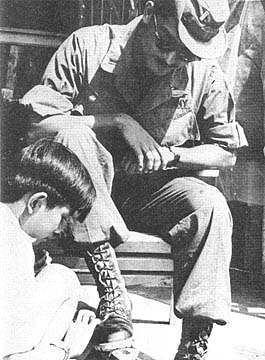 |
ONLY AFTER SCHOOL - Nuynh Van Khoan gives that extra little touch to the boots of 1LT Alfred Serrato. (Photo by SGT Roger Smith) |
All Mahogany Bridge Built
1ST BDE - When the 25th Inf Div's 588th Engr Bn was assigned the job of
constructing a bridge on Route 4, about 60 kms northeast of Tay Ninh, they
decided to utilize local materials. Looking around, they discovered there were
enough huge mahogany trees to provide necessary beams for the bridge.
The construction began with the preparation of the approaches and supports
which were made ready to receive the six 3 foot by 60 foot logs that were to
form the clear-span timbers. The logs were cut in the jungle near the road,
hauled to the bridge site, emplaced side-by-side, and smoothed off to provide a
level bridge surface.
Decking was nailed crossways on the logs, and planking for vehicle treadway
was nailed on top of that.
SFC Willie Boulware from High Point, N.C., who is the platoon sergeant of Co
C and in charge of the construction, said, "The hardest part was cutting and
trimming the logs. That mahogany is darn hard wood, and we had to stop and
sharpen our chain saws every few minutes."
Less than a week after construction began, traffic was crossing the bridge.
Due to the great strength and number of logs used, the bridge has been
designated as Class 100 (more than capable of supporting any vehicle the Army
has).
"As far as we know," says Boulware, "It's the only solid mahogany bridge ever
built. A man who worked in the import-export business estimated that the logs
used in the bridge would cost about $9,000 back in the states."
In addition to its load-bearing capability, tests by demolition men have
shown the massive bridge to be almost indestructible. Shape charges and plastic
explosives had almost no effect when detonated on one log. "This is an added
feature we hadn't planned on," said Boulware.
Barring some natural catastrophe, the engineers say the bridge will last over
300-years, pretty good for a project completed in four days.
Page 7 TROPIC LIGHTNING NEWS February 5, 1968
Quick Thinking Ambush Patrol Kills 7 VC
3RD BDE - Quick thinking by an ambush patrol that was caught in the direct
line of attack on the 3rd Bde, 25th Inf Div fire support base Burt resulted in
their pulling back to a bomb crater where they held off an all night attack
killing at least seven enemy troops. This action took place during the Battle
of Soui Cut that resulted in 382 Viet Cong killed.
The ambush patrol from Charlie Co, 2nd Bn (Mech), 22nd Inf, was led by SSG
Mark Ridley of San Antonio, Tex, with only two weeks in country. Although the
New Year Truce was in effect, previous mortar attacks which had broken the truce
prompted the "Triple Deuces" battalion commander, LTC A.G. Norris, to send the
ambush patrol out as counter-mortar security for the support base.
Leaving the southern end of the perimeter at 6:30 p.m. the patrol traveled
400 meters down a main trail before angling in to the right. "We had been set
in place for half an hour," said Ridley. "Around 7:30 the perimeter opened up
and a little later we began to hear the Viet Cong talking all around us."
"Then some Viet Cong came down the path, led by a man with a flashlight,"
commented PFC William Thompson from Seabrook, Tex. "We threw some hand grenades
and got them."
By then SSG Ridley had received word that the whole fire support base was
under heavy enemy contact. With friendly .50 cal. and enemy fire cracking
overhead, the patrol crawled to a bomb crater where they set up in a circle.
It took only a moment for the men to realize that they were in the line of a
major attack on their battalion, and their only chance for survival lay in
maintaining a purely defensive posture. For the rest of the night, the patrol
called in artillery concentrations and provided targets for the gunships and
aircraft pounding the enemy's line of attack between their position and the
perimeter.
The only reply to the enemy heavy small arms fire and hand grenades thrown by
the circling enemy troops was defensive fire to keep the enemy at bay. PFC John
Marts from Owaneco, Ill, kept his M-60 machine gun below ground level until he
could see enemy troops creeping up to throw grenades. "We knew we were
surrounded and would not be relieved until dawn," said Marts. "To conserve ammo
I waited until they came close enough so I couldn't miss and then put a few
bursts into the enemy and got back down in the hole."
The only casualty came when a CHICOM RPG-2 round hit the lip of the crater,
lightly wounding one of the men.
By dawn the unsuccessful attack had been beaten back, and a reinforcing
element had moved to the ambush site to escort the patrol back to friendly
lines. Seven enemy bodies were found within 15 meters of the bomb crater, and
four heavy blood trails led from the immediate area.
"It was a real hairy experience," remarked Ridley back at the fire support
base, "and I never want to go through anything like that again."
Squad Surprises Cong In Attempted Ambush
CU CHI - SGT Vince Iacono, 20, of Brooklyn, N.Y., knew his patrol had to stop
the Viet Cong at all costs before they reached Highway 1, where they would
probably hit the 3rd Sqdn, 4th Cav's Armored column.
PFC Ed Weik of Bantam, Conn., was the first man in the Alpha Trp patrol to
spot the approaching Viet Cong in the darkness. Passing the night vision
Starlite Scope to Iacono, the squad prepared for a fight.
When the lead VC was within 15 meters of the hidden cavalrymen, Iacono gave
the signal to open fire. The sergeant was to comment later, "We must have
really surprised them . . . they didn't put up much of a fight."
After the enemy apparently withdrew, Iancono, with Weik and SP4 Andy Garnica
from Richmond, Calif., moved forward to check for enemy casualties, leaving the
rest of the patrol in position.
They found one body with an automatic rifle lying next to it. As they
started to move forward again, small arms fire erupted from a dirt berm to their
front. A bullet slammed into Iacono's shoulder.
Disregarding his wound, the sergeant with Weik and Garnica, started moving
toward the VC position.
Two more bullets slammed into Iacono. Both Weik and Garnica pulled the
wounded man to cover and bandaged his wounds as bullets snapped over their
heads.
With Iacono's bleeding stopped, Garnica moved forward a few yards and hurled
a grenade over the berm into the middle of the Viet Cong.
PFC David Kipple of Daggett, Mich., had moved up from the rear when the
firing started, and arrived in position in time to kill three more VC that had
been flushed out by Garnica's grenade.
A radio call by SP4 Frank Rompel of Allen Park, Mich., brought in the 1st
Plt's reaction team to back up the patrol. With the team in position, the
cavalrymen moved forward. A sudden noise to the front of PFC Steve Alvardo of
San Antonio, Tex., caused him to fire an M-79 grenade into the brush, killing
another VC.
Minutes later a helicopter arrived and took Iacono to the 25th Div's 12th
Evac Hosp.
The enemy's attempt at an ambush cost them dearly . . five dead and the
capture of six weapons.
"We really did surprise them," said Iacono later in the hospital, "because
one of my men told me that the first VC we killed had an empty weapon."
Snake Hadn't Heard About "Quality" Of Army Chow
1ST BDE - When the 25th Inf Div's 588th Engr Bn moved to Katum, 60 kms
northeast of Tay Ninh, they set up in a heavily wooded area and thus came into
contact with a large number of jungle creatures. They share their bunkers and
tents with frogs, lizards, spiders, and in one case, a large snake.
The engineers were getting ready for chow one day when the cry went out,
"snake, a great big snake!"
The commanding officer of Co D, CPT Larry M. Pigue of Little Rock, Ark., came
running to investigate and was amazed to find a 12-foot python moving slowly but
surely through the battalion area, making straight for the mess hall. SGT David
M. Beaver of Royal Oak, Mich., joined forces with Pigue in an effort to chase
the snake off with rocks and sticks, but to no avail.
When it became apparent that the snake was determined not to retreat
peacefully, Pigue drew his pistol and shot him. It took four shots in the head
to stop the huge snake, who almost made it into the mess tent before he died.
SP4 Roger L. Gardner, from Madison Heights, Mich., who had civilian
experience as a taxidermist, skinned the snake and mounted the skin on a long
plank. The dried skin now stands on display outside Gardner's bunker, a
reminder for all to keep constantly alert while in the jungle.
Battalion spokesmen feel the snake was attracted by the smell of food from
the messhall, and was so hungry that he ignored all attempts to run him off.
The mess sergeant later remarked that it was a good thing the snake was stopped,
since only enough food had been prepared for the men - there were no portions
allocated for "visitors."
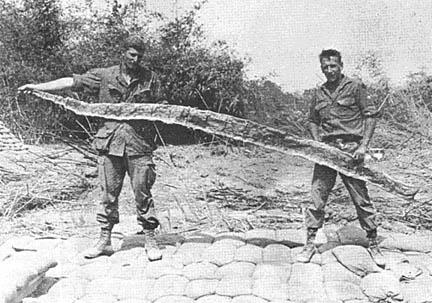 |
DRIED OUT - SP4 Roger L. Gardner (right) and PFC Chuck Galloway hold up dried skin of a 12-foot python that invaded their camp in search of some Army chow. |
Mortar Round Cache Found
3RD BDE - Daily mortarings are a part of the facts of life in the dense
jungles along the Cambodian border, but an opportune discovery by Alpha Co, 2nd
Bn (Mech), 22nd Inf, provided a welcome break in the usual routine.
One afternoon recently the "Triple Deuces" of Alpha Co, commanded by CPT Alan
R. Wetzel, was sweeping through border jungles when they discovered an enemy
base camp. Sniper fire cracking overhead informed Alpha Co that the occupants
were still in the neighborhood. Quickly returning fire, they killed the sniper
and captured his AK-47 assault rifle.
A search of the base camp showed it was presently in use; cooking utensils
were found in quantity, and the fish in pots had not even begun to sour.
Then came the big finds. While searching the base camp, the men found three
RPG-2 and two, RPG-7 anti-tank rounds. They then uncovered a cache of 76 60mm
mortar rounds. The base camp and the enemy munitions were destroyed.
The riflemen of Alpha Co insist that their afternoon's work enabled the men
of the battalion to sleep well that night. Charlie's nightly mortar attack
never materialized.
Stranded GIs Survive Night
3RD BDE - "If our patrol had been located 15 meters away in any direction,
none of us would have survived," stated PFC John M. Golden from Westminster,
Calif.
The ambush patrol from Charlie Co, 3rd Bn, 22nd Inf, had set up 350 meters
from the perimeter of fire support base Burt near the Cambodian border. A few
hours after dark the patrol came under heavy Viet Cong mortar, RPG and small
arms fire.
With the only radio knocked out of commission and men wounded, the patrol was
forced to remain in position. "We couldn't move because we didn't know where
the Viet Cong, were," commented Golden.
In the meantime the enemy was advancing all around the patrol in their attack
upon the fire support base. With both enemy and friendly fire dropping around
their position, the uninjured patrol members bandaged the wounded for the rest
of the night.
Only when morning arrived was the patrol able to receive aid from the base
camp and return to safety.
Katum Now Has 'Swap' Library
1ST BDE - When SP5 William Neibauer of Shanokin, Pa., arrived at the 25th Inf
Div's 1st Bde base camp at Katum, he noticed that reading material was almost
nonexistent.
So he obtained a small supply of books and magazines from Special Services,
placed them on his bunker in an ammo box with the sign "One for One" and opened
for business.
"A lot of the men had brought a book or a magazine with them, and were glad
to have a place they could exchange them for something they hadn't already
read," Neibauer said.
"Neibauer's Field Library" is now a popular gathering place in the evenings.
When He Plays Homemade Horn Better Watch Out For Elephants
1ST BDE - The first time WO Robert Lockhart played his trumpet, a large crowd
gathered. "I was kind of proud," he recalls, "until someone asked where the
elephant was."
Lockhart of Sayreville, N.J., is the maintenance officer for the 25th Div's
588th Engr Bn. He got the urge to play the trumpet one day, so since he
couldn't find one in the field he had to make his own.
Taking a short length of hydraulic line and part of an airhorn assembly, he
fashioned a crude, but playable instrument.
"You can't really improvise a complicated song," Lockart confesses, "but I
can play 'Taps,' 'Retreat,' and 'Charge'."
He is now working on "Love is a Many Splendored Thing."
Page 8 TROPIC LIGHTNING NEWS February 5, 1968
Big Ammo Cache Found Near 'Burt'
3RD BDE - An old Viet Cong base camp 1500 meters outside of fire support base
Burt yielded a large store of munitions to a careful search by men of the 3rd
Bde, 25th Inf Div.
Bravo Co, 3rd Bn, 22nd Inf, led by CPT Robert L. Hemphill from Lavonia, Ga.,
discovered the recently hidden explosives while on a reconnaissance patrol.
"We knew from the numerous VC footprints nearby and the perfect condition of
the stores that, they had been hidden only a few days ago," explained Hemphill.
The discovery included 156 60mm mortar rounds, 3 82mm mortar rounds, 13,750
rounds of AK-47 ammunition, 41 cases of TNT, 24 cases of C-4, and 14,400
non-electric blasting caps.
The mortar rounds were carefully packed twelve to a box and the fuses and
warheads were separately packaged in small metal boxes to insure that the rounds
didn't accidentally explode while being transported.
Using the TNT and C-4, the "Regulars" destroyed the entire bunker complex.
The mortar rounds which had been packed were brought back to the fire support
base for experimental study.
| BOXES FULL - A small representation of the total weapons cache found by men of the 3rd Bn, 22nd Inf, on Operation Yellowstone. (Photo by SP4 Pete Earl) | 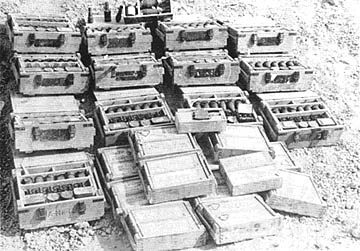 |
Viet Language Barrier Has Them On The Run
1ST BDE - PFC Jimmy Adler of Caldwell, Idaho, latched on to a North
Vietnamese soldier, but because of the language barrier, the detainee had Adler
on the run.
Describing the incident, Adler explained that he had stumbled over the enemy
soldier during a 25th Div search and destroy mission in War Zone C. At the
time, Adler was flankman which pulled him to one side of the 2nd Bn, 14th Inf's
Alpha Co, as they swept through the heavy brush.
"He was lying behind a large ant hill," Adler added, "and I was on top of him
before I knew it. In fact, he was lying so still, I thought he was dead."
Adler pointed his M-16 at the man and motioned for him to get up. The
flankman found the enemy soldier was carrying an RPG-2 anti-tank rocket launcher
and three rounds.
According to Adler, it was about this time that things became confused.
"When we started moving to catch up with the company, I motioned to the man to
get his hands up higher, but all he did was walk faster. He kept lowering his
hands and I kept motioning for him to raise them, but he kept moving faster. By
the time we reached the company, both of us were running.
Interpreters later questioned the enemy soldier and found out he had become
separated from his unit during an air strike. Immediately after that, Adler's
company had been dropped in by helicopter, cutting him off from escape.
He later asked the interpreter why the American insisted on his walking so
fast.
2nd, 77th Arty Names New CO
CU CHI - LTC William L. Albright has assumed command of the 2nd Bn, 77th
Arty, replacing LTC A. T. Lindholm.
Albright was the 25th Div Arty S-3 before assuming command. He came to
Vietnam from Ft. Leavenworth, Kan., where he was projects officer of the
Institute of Combined Arms and Support.
Among the colonel's awards and decorations are the Bronze Star Medal, Army
Commendation Medal, Air Medal and the Purple Heart.
WO Flies Strange Dust-off
1ST BDE - WO Donald Evans of Atlanta, recently flew one of the strangest
dust-off missions of his career.
The strange flight started at dawn when Evans received word of an immediate
dust-off required at the Special Forces camp at Prek Klok, 35 kms
north-northwest of Tay Ninh City.
Nearing the pick-up point, he received a radio message advising him to hurry
because the patient was in serious condition.
The second he sat down on the helicopter pad, two medics ran out carrying a
poncho-covered stretcher and quickly lifted the evacuee into the small cockpit
of the OH-23.
It was a tight fit, because the patient was a large Labrador Retriever
tracker dog, who had been wounded during a combat mission.
Evans flew the dog and his handler to the 25th Div's 1st Bde base camp at
Katum, where he was transferred to another helicopter for evacuation to the Cu
Chi veterinary clinic.
"I had no idea that I was going to evacuate a dog," said 'Evans with a
smile. "I was surprised, and glad we got him to the doctor in time."
Classrooom For 150 Discovered By Saigon River
3RD BDE - One of the most unusual enemy fortifications found by the 2nd Bn (Mech),
22nd Inf, was discovered by a platoon from Bravo Co while on a search and
destroy mission near the Saigon River, 60 kms northwest of Saigon. A freshly
dug classroom for at least 150 people was found, with the top of the seats at
ground level and the seats and aisles dug into the ground.
Small trees which were left growing supported numerous interwoven vines used
to shield the area from the air.
The classroom was found in an area where a number of huge enemy base camps
were destroyed. The classroom consisted of seven double rows of seats with
aisles down the middle and sides. The seats were lined with wooden boards.
25th Div Base Camp Mortared
The 25th Inf Div's base camp at Cu Chi received 48 rounds of 82mm mortar and
recoilless rifle fire Jan. 19.
The 20-minute attack, which began at 7:48 p.m. resulted in three U.S.
soldiers killed and 45 others wounded. Thirty-two of the wounded soldiers were
treated and released. There was light damage to U.S. facilities and equipment.
Counter-mortar fire and helicopter gunships pounded suspected enemy
positions. The results are unknown.
Thanks to:
Joe Carey, 25th Admin. Co.,
for sharing this issue,
Kirk Ramsey, 2nd Bn., 14th Inf. for creating this page.
This page last modified 11-05-2005
©2005 25th Infantry Division Association. All rights reserved.